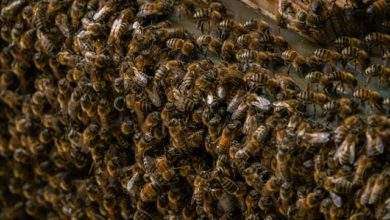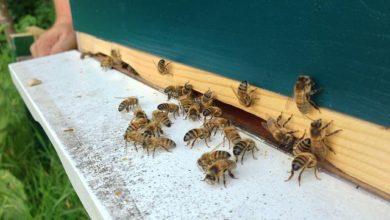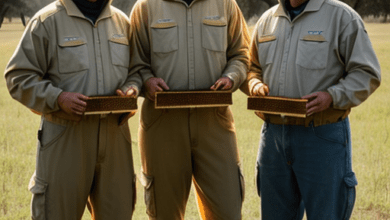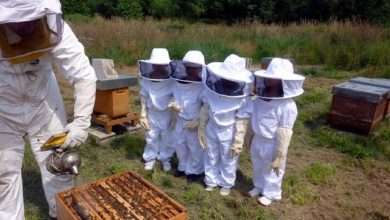Safety Tips for Beekeepers

Importance of Safety in Beekeeping
Beekeeping is a fulfilling and worthwhile hobby, but it comes with its own set of risks. Handling bees and working with hives requires a great deal of care and caution. With the proper precautions and knowledge, beekeeping can be a safe and enjoyable experience.
This article will discuss the importance of safety in beekeeping and offer tips to help you stay safe while you work with your honeybees.
Risk of Stings
The most common danger associated with beekeeping is the risk of being stung by a bee. Some people are more sensitive to bee stings than others, and for those people, a sting can be dangerous or even life-threatening. Even if you are not allergic to bee stings, they can still be painful and unpleasant.
As a beekeeper, your attire and tools are your first line of defense against any unwanted stings or injuries. Wearing proper gear and handling equipment correctly can ensure a safe and successful beekeeping experience.
Beekeeper Protective Clothing
As a beekeeper, it is important to wear the proper protective clothing to avoid getting stung. The following are some important things to know about beekeeper protective clothing:
Types of Protective Clothing

There are a variety of protective clothing options to choose from. Some common options include:
- Bee suits: Cover the entire body and usually come with a veil to protect the face and neck.
- Jackets: A beekeeping jacket is the next crucial piece of attire. It should be made from breathable material, preferably cotton or a blend of cotton and polyester, and should cover your torso and arms.
- Gloves: The gloves should provide ample protection and coverage, but be flexible enough to allow handling of equipment. Recommended gloves are typically made of leather and cover the hand and wrist.
- Boots: High leather boots offer excellent protection for your feet and ankles.
Materials Used in Protective Clothing
Protective clothing is typically made of lightweight, breathable materials that provide protection from bee stings.
Common materials include:
- Cotton: A lightweight and breathable material that is a good option for beekeeper jackets and pants.
- Synthetic materials: Polyester and nylon are popular choices for bee suits and jackets because they are lightweight and provide good protection from bee stings.
Selection of Protective Clothing
When selecting protective clothing for beekeeping, there are several things to consider, including:
- Level of protection: Choose clothing that provides adequate protection from bee stings. Bee suits and jackets should be thick enough to prevent stingers from penetrating the material.
- Comfort: Beekeeping can be a hot and sweaty activity, so choose clothing that is lightweight and breathable to prevent overheating.
- Mobility: You will need to be able to move around easily while wearing your protective clothing, so make sure it is not too restrictive.
Maintaining Protective Clothing
To ensure the longevity of your beekeeper protective clothing, it is important to take proper care of it. Some tips for maintaining your protective clothing include:
- Washing: Wash your protective clothing after each use with a gentle detergent to remove any dirt and debris. Avoid using bleach or fabric softeners, which can weaken the material.
- Storage: Store your protective clothing in a cool, dry place to prevent mold and mildew growth.
- Repairs: It is important to repair any holes or tears in your protective clothing to prevent bees from getting in.
Wearing the proper protective clothing while beekeeping is important for avoiding bee stings. Consider the type of clothing, material, fit, and maintenance when selecting and caring for your protective clothing. With proper use and care, your protective clothing can last for many years of successful beekeeping.
Beekeeper Tools
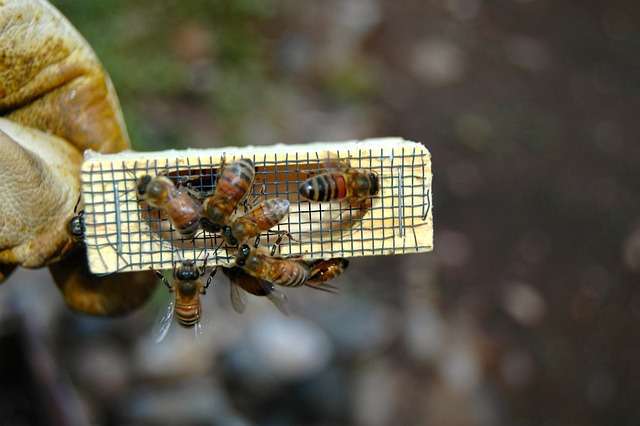
- Smoker: A smoker is an essential tool for beekeepers. It helps produce smoke that calms the bees and makes them easier to work with. A smoker also masks the pheromone released by the protector bees, which reduces the chances of getting stung.
- Hive Tool: A hive tool is a metallic tool used to open the hive and remove frames that contain honey or brood. It can also be used to scrape the wax and propolis from the frames and boxes. Hive tools come in different designs, but the most common one is the J-hook style.
- Bee Brush: A bee brush is used to brush off bees that may have landed on the protective clothing or on the frames. It should be soft and gentle to avoid harming the bees. A bee brush should be used with care because excessive brushing can damage the delicate wings of the bees.
- Queen Catcher: A queen catcher is used to catch the queen bee for inspection or transfer purposes. It is a small plastic or metal tool that has a clip mechanism that secures the queen bee. Queen catchers come in different designs, but the most common one is the clip-shaped catcher.
Proper Handling of Bees
Beekeeping can be a rewarding experience, but it requires proper care and handling of bees. As beekeepers, your primary job is to ensure that your bees are healthy and producing enough honey for your needs.
Here are some tips on how to handle your bees properly:
- Approach the hive calmly: When approaching the hive, move slowly and smoothly. Bees are sensitive to vibrations and sudden movements, which can agitate them.
- Be observant: Before handling the bees, observe their behavior. A healthy hive is usually calm and quiet. If the bees are agitated, it may mean that something is bothering them, and you should investigate further.
- Use a smoker: A smoker is a common tool used in beekeeping to calm bees. The smoke from the smoker helps mask the alarm pheromones that bees release when they feel threatened. Use the smoker sparingly to avoid harming the bees.
- Handle the frames carefully: When inspecting the hive, handle the frames with care. Bees attach the comb to the frames with wax, and they can break off if you handle them roughly. Gently lift the frames and avoid crushing the bees.
- Be gentle with the bees: Handling bees takes practice and patience. Be gentle with the bees and avoid squishing them. Remember that bees are important pollinators, and they are essential for our environment.
Importance of Regular Maintenance
Regular maintenance of your beekeeping equipment and hives is also an important aspect of beekeeping safety. Proper maintenance can help to prevent accidents and ensure that the equipment is functioning properly. Taking the time to inspect hives and gear before use can prevent accidents and injuries.
Preparation Before Beekeeping
With proper preparation and knowledge, you can reduce the risk of accidents and enjoy your time with bees.
Here are some things to consider:
- Learn the Basics: Before starting beekeeping, it is important to learn the basics of the hobby. To get started, consider attending a workshop or finding a mentor. You should also read books or online articles that cover beekeeping essentials such as how to properly handle bees, how to set up a hive, and how to maintain colonies.
- Invest in the Right Equipment: Beekeeping requires specific equipment to ensure that both you and your bees are safe. Purchase quality protective gear, such as a beekeeping suit, gloves, and a veil. Don’t forget to invest in tools like a smoker, hive tool, and bee brush.
- Find the Right Location: The location of your hives can have a significant impact on the success of your beekeeping hobby. Choose a location that is relatively flat, gets morning sun and afternoon shade, and is away from areas of heavy foot traffic. It is also important to check local ordinances and laws regarding beekeeping in your area.
- Set Up the Hive Properly: Before introducing bees to your hive, make sure it is properly set up. Follow the manufacturer’s instructions for assembly and consider adding a baseboard, queen excluder, and a feeder. This will create a safe and secure home for your bees.
Safety Measures
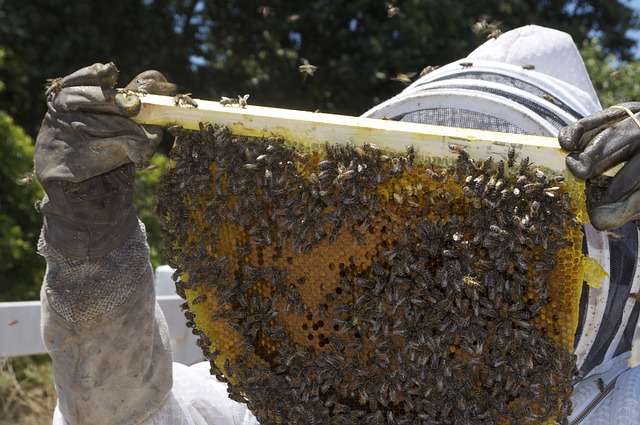
Before starting, a beekeeper should have proper training and knowledge of bee behavior. The beekeeper must wear the necessary protective gear such as a bee suit, gloves, and a hat with a veil.
The hive smoker should be operated in a way that ensures all areas of the hive are exposed to the smoke while making sure not to overdose the hive. The smoker should be lit in a non-flammable area and should be secure from falling over.
Make sure that you have a clear understanding of the dangers involved in beekeeping and what to do in case of an emergency.
Be sure to have a well-stocked first aid kit nearby, and to practice safe handling and maintenance procedures.
Conclusion
Beekeeping can be a rewarding hobby or profession, but it is important to prioritize safety to ensure that you are not harmed during the process. Protective clothing, a smoker, a hive tool, a bee brush, and a queen catcher are essential tools for handling bees, and you should always use them when working with your bees. By following these safety measures, you can enjoy beekeeping without any risks.
Frequently Asked Questions
What is Beekeeping Protective Gear?
Beekeeping Protective Gear is clothing and equipment designed to protect beekeepers from bee stings and other hazards while working with bees.
Why is it important to wear Beekeeping Protective Gear?
It is important to wear Beekeeping Protective Gear to protect against bee stings, which can cause pain, irritation, and even severe allergic reactions in some people. Additionally, protective gear can prevent beekeepers from getting stung on their face and head, which can be particularly dangerous.
Is Beekeeping Protective Gear comfortable to wear?
Most Beekeeping Protective Gear is designed to be lightweight and breathable, with adjustable straps and cuffs for a comfortable fit. However, it may take some getting used to, especially for beginners.
How do I choose the right size Beekeeping Protective Gear?
Choose the size of the Beekeeping Protective Gear based on your body measurements, not your regular clothing size. Refer to the manufacturer’s sizing chart to ensure a proper fit.
How often should I replace my Beekeeping Safety Equipment?
Replace your beekeeping protective equipment as soon as it becomes damaged, torn, or worn out. If you use it frequently, it may need to be replaced every 1-2 years.
What should I do if I get stung by a bee?
If you get stung by a bee, the first thing to do is remove the stinger by scraping it off with a dull object such as a credit card. Then, clean the area with soap and water and apply a cold compress to reduce swelling and pain.
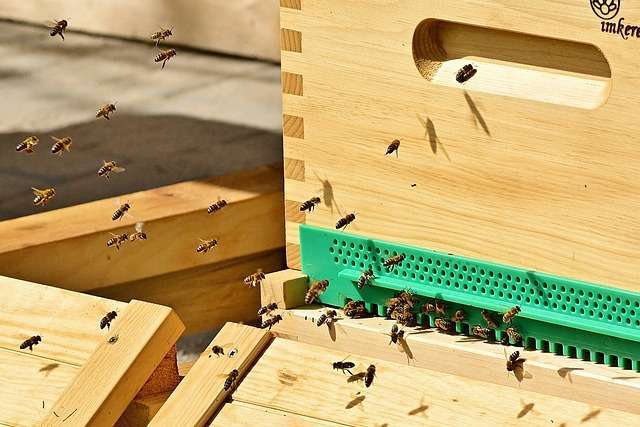
Can I customize my Beekeeping Safety Equipment?
Yes, you can customize your Beekeeping Safety Equipment by adding patches or embroidery with your name, logo, or other designs. However, it is essential to make sure that the customization does not compromise the quality or safety of the gear.
Can I wear regular clothing instead of Beekeeping Protective Gear?
While it is possible to wear regular clothing while beekeeping, it is not recommended. Bees can easily find their way through loose clothing, and a single sting can be very painful. Additionally, regular clothing does not offer protection from other hazards such as sharp tools or hot wax.
How do I properly store my Beekeeping Safety Equipment?
Beekeeping Safety Equipment should be stored in a cool and dry place, away from sunlight and moisture. It is best to store them in a sealed container or bag to prevent dust and dirt from accumulating.

